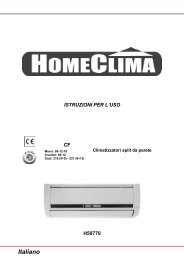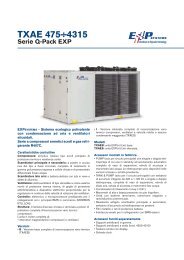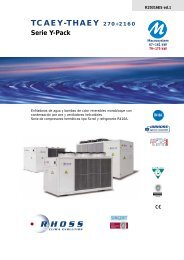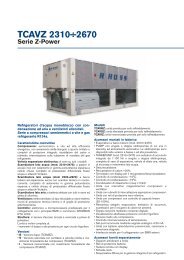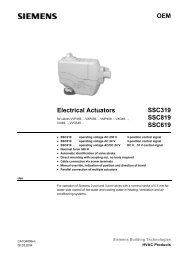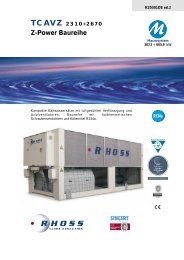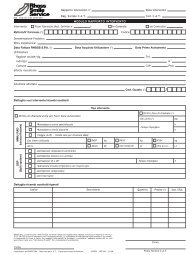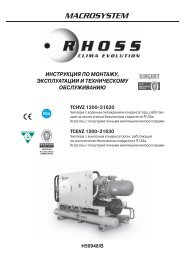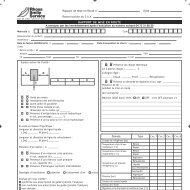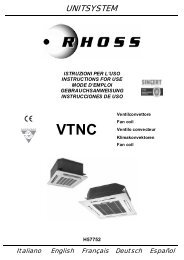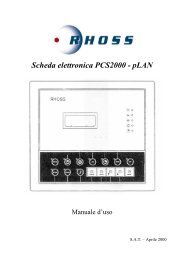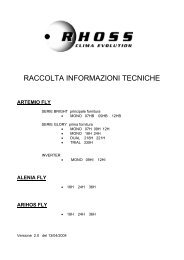tcaes 230÷4160 thae - Rhoss
tcaes 230÷4160 thae - Rhoss
tcaes 230÷4160 thae - Rhoss
Create successful ePaper yourself
Turn your PDF publications into a flip-book with our unique Google optimized e-Paper software.
SECTION II: INSTALLATION AND MAINTENANCE<br />
Fig. 11<br />
1. TCAE-TCAES-THAE-THAES<br />
2. Auxiliary cock<br />
3. Gate valve<br />
4. Wash pump<br />
5. Filter<br />
6. Acid tank<br />
II.4.3 SEASONAL BREAKS<br />
DANGER!<br />
When the appliance is not used for long periods of<br />
time, disconnect the unit by opening the general<br />
isolator with door interlock on the power circuit.<br />
To avoid the migration of coolant into the compressor while the<br />
appliance is not in use, stock the coolant charge in the condensing coils<br />
by carrying out a pump-out procedure.<br />
II.5<br />
SPECIAL MAINTENANCE<br />
IMPORTANT!<br />
Maintenance work must be carried out by skilled<br />
technicians from service centres authorised by<br />
RHOSS, qualified to work on this type of product.<br />
DANGER!<br />
Do not introduce pointed objects through the air<br />
delivery intake grilles.<br />
DANGER!<br />
Always act on the disconnecting switch to<br />
disconnect the unit from the mains power supply<br />
before carrying out any maintenance work, even if<br />
you only intend to make an inspection.<br />
DANGER!<br />
In the case of cooling or fan circuit component<br />
breakage or a drop in the coolant gas charge, the<br />
upper part of the compressor casing and the<br />
discharge line may reach temperatures as high as<br />
180°C for brief periods of time.<br />
II.5.1 REPAIRS AND COMPONENT<br />
REPLACEMENT<br />
• If any of the cooling circuit components need replacing, it is<br />
necessary to bear in mind the indications in the following Paragraphs.<br />
• Always refer to the wiring diagrams enclosed with the appliance<br />
when replacing electrically powered components. Always take care to<br />
clearly label each wire before disconnecting to avoid making mistakes<br />
later when re-wiring.<br />
• When the machine is started up again, always repeat the start-up<br />
procedure outlined in Paragraph II.2.3.7.<br />
• After carrying out any maintenance work, keep an eye on the liquidmoisture<br />
sight-glass (LUE). After the appliance has been running for at<br />
least 12 hours the cooling circuit must be completely “dry” and the LUE<br />
must be green, otherwise replace the filter.<br />
II.5.1.1 Topping up or replacing the coolant<br />
○ The units are factory tested with a suitable coolant charge. When<br />
the charged is replaced or topped up, the ambient and working<br />
conditions of the appliance must be taken into account.<br />
○ While the unit is running the coolant may be topped up on the low<br />
pressure branch, upstream of the evaporator, using the pressure<br />
connections provided. Any topping up of coolant must be carried out<br />
while the coolant is in a liquid state to avoid changing its composition.<br />
○ While topping up, watch the liquid indicator to make sure the liquid<br />
is completely clear without any bubbles whatsoever.<br />
○ Only restore the gas charge following maintenance operations on<br />
the cooling circuit after the circuit has been washed-out very carefully<br />
and after the following operations have been carried out:<br />
• install an antacid filter on the compressor inlet and then run the unit<br />
for at least 24 hours;<br />
• check the degree of acidity, if necessary change the gas and oil and<br />
then run the unit for at least 24 hours;<br />
• remove the antacid filter cartridge.<br />
II.5.1.2 Compressor operation<br />
While the unit is switched off, the oil level in the compressors must<br />
reach half way up the sight glass on the casing. The oil may be topped<br />
up after pumping-out the compressors, using the pressure connection<br />
on the compressor inlet.<br />
Whenever the overload protection is triggered, normal running<br />
conditions are automatically restored when the temperature of the<br />
windings falls below the set safety value (this could take from a few<br />
minutes to some hours). The power circuit overload protection is<br />
managed by the microprocessor controller. Once the overload<br />
protection has been triggered and reset, it is necessary to reset the<br />
alarm on the control board. We recommend installing a remote<br />
controlled lamp/LED signal for each compressor to warn that the<br />
overload protections have been triggered.<br />
II.5.1.3 ST2 antifreeze safety temperature sensor<br />
operation<br />
After the sensor has been activated, the alarm on the control board<br />
must be reset. The unit restarts automatically only when the water<br />
temperature exceeds the intervention differential.<br />
Check the efficiency of the antifreeze protection with the help of a<br />
precision thermometer immersed with the sensor in a container full of<br />
cold water at a temperature below the antifreeze alarm temperature<br />
setting. This may be done after the sensor has been removed from the<br />
pocket on the evaporator outlet; take care not to damage the sensor<br />
while removing it from its pocket. The sensor must be replaced with the<br />
utmost care: introduce some conduction paste into the pocket, insert<br />
the sensor and re-seal the external part with silicone to prevent it from<br />
slipping out.<br />
II.5.1.4 VTE/VTI thermostat operation<br />
The thermal expansion valve is calibrated to maintain the gas<br />
superheated by at least 6°C, to avoid any liquid being sucked into the<br />
compressor.<br />
If the superheating setting needs to be changed, act on the valve as<br />
follows:<br />
1. Bulb with MOP charge<br />
2. Equalisation capillary connection<br />
3. Valve body<br />
4. Superheating adjustment screw<br />
Fig. 12<br />
Remove the screwcap on the side of the valve and then act on the<br />
adjustment screw. By increasing or decreasing the amount of coolant,<br />
the superheating temperature value is either decreased or increased.<br />
The temperature and pressure inside the evaporator remains more or<br />
less the same, regardless of changes to the heat load. After any<br />
adjustments to the valve it is advisable to allow a few minutes to elapse<br />
to give the system the chance to re-stabilise.<br />
18



